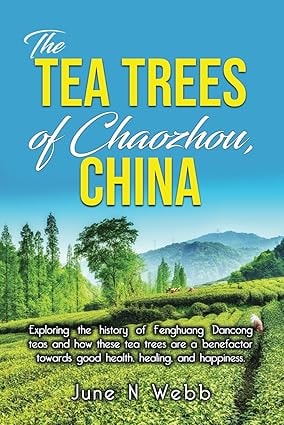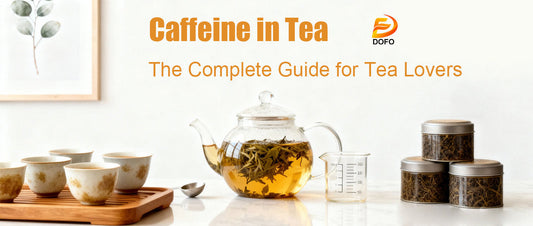
The Rich History of Tea: From Ancient Traditions to Today’s Culture
钱多福Share
There is a link to the book "Chaozhou Tea Trees" below the text
I met my American friend June, a renowned author, by chance online. Our shared love of tea helped us transcend language and cultural barriers. After many passionate conversations, our authentic Phoenix Mountain Dancong tea made its way overseas.
When June finally sipped its natural floral fragrance, He also discovered the charm, history, and traditions of Tea culture.
Origins of Tea
Tea begins with its legendary origins in China, where it is believed to have been discovered by Emperor Shen Nung in 2737 BCE, and its early introduction in Japan by Buddhist monks in the 9th century.
The Chinese word for tea was likely derived from non-Sinitic languages of the botanical homeland of the tea plant.
Tea plants are native to East Asia, with the probable center of origin near the source of the Irrawaddy River.The tea plant is considered to be within a small fan-shaped area between China, Myanmar, and Thailand.
Chinese small-leaf tea may have originated in southern China, while Assam tea may have originated in western Yunnan.
Legends from China and India
In the rich tapestry of tea’s history, legends from China and India play a pivotal role.
History of Tea
From the ancient Silk Road to modern globalization, tea has always played an important role in connecting different cultures and nations.

Rise of the tea
Tea consumption became widespread in China during the Tang dynasty (618-907).
A government-imposed tea tax further evidences the beverage’s growing popularity. During the rise of tea consumption in England, coffee houses were popular gathering places, primarily frequented by men before women began to embrace tea more widely.
Promotion of Tea
Tea was first enjoyed in China around 2737 BC, later spreading to Japan and Europe
Tea was introduced to Japan by a Japanese Buddhist monk, Saichō, in the 9th century.The most popular method of preparing tea involved grinding green tea leaves into a fine powder.The traditional Japanese tea ceremony (“Chanoyu”) was popularized by the Zen monk Eisai.Matcha is prepared with bamboo whisks and served in hand-crafted bowls.
Tea spreads to Europe
Tea spread from Eastern countries to Western countries.
Tea Innovations
From Tea Bags to Iced Tea
Tea bags were originally handmade from muslin or silk, with patents appearing as early as 1903. Thomas Sullivan is credited with the first commercial tea bag in 1907, though it gained popularity only after World War II.
Iced tea debuted at the 1904 St. Louis World’s Fair. The pyramid tea bag, introduced in 1996, aimed to satisfy connoisseurs but faced environmental criticism. Instant tea, an alternative to brewed tea, was developed in the 1930s.
Tea trade development
Tea is mainly grown in Asia and Africa, with smaller areas in South America and near the Black and Caspian Seas.
The top producers are China, India, Kenya, and Sri Lanka, with global output reaching 29.8 million tonnes in 2022—China accounting for 49% and India 20%.
Classified by processing, tea is a key export, historically driven by major traders like the British East India Company, which shaped global commerce.
From its origins in China to its place in British life, tea has influenced cultures and economies worldwide for centuries.
Tea Drinking Culture
Tea gradually becomes popular in various countries
Globally, the tea drinking methods and cultural significance of tea are unique, but without exception, tea has become a part of daily life,becoming a modern tea drinking
- In the United States, tea is more than a drink—it’s part of social life. Tea parties, tastings, and cultural events are now common at gatherings, family dinners, and in offices. More Americans are discovering that tea carries not only rich flavor but also a deep history and philosophy.
- In the UK, afternoon tea has become an elegant social ritual;
- in Japan, the tea ceremony carries a deep Zen and etiquette;
- in India, strong masala tea has become a unique landscape in the streets and alleys.
Whether in the East or the West, tea is not just a drink, but also a symbol of culture, a way of sharing and communication.
The types of tea began to become more diverse

The spread of tea culture

The spread of tea culture has fostered cultural exchange and integration. Drinking tea shares not only its aroma but also stories and ideas. As a global language, tea bridges people from different backgrounds, allowing its culture to take root worldwide and reveal its lasting charm.
I and my friend are all tea culture disseminators, and everyone can be one of them.
After learning about the history and culture of tea, June Webb published a book, "Chaozhou Tea Trees" in which he mentioned Fenghuang(Phoenix) Dancong tea "every sip of tea makes people feel as if they have entered a quiet tea garden, with a fresh aroma and endless aftertaste". This book is not only a book about tea, but also a disseminator of Chinese tea culture. Through his words, tea is not only a taste enjoyment, but also a bridge for cultural exchange.
Fenghuang (Phoenix) Dancong Tea
Fenghuang(Phoenix) Dancong tea is indeed a very unique chinese tea with strong local characteristics.It comes from Fenghuang Mountain in Chaozhou, Guangdong Province, China, and is famous for its unique aroma and taste.Fenghaung(Phoenix) Dancong tea has a variety of flavor types such as "floral fragrance", "fruity fragrance" or "honey fragrance", and these flavor changes are closely related to the origin, variety and production process.

As a tea garden dedicated to providing high-quality single-bush tea, we always adhere to the traditional tea-making process, plant tea trees and growing tea to select good tea leaves, and strive to convey the unique charm of Phoenix Mountain in every piece of tea.
If you also want to experience the beauty of this tea in person, please visit our Dofo Tea to buy it and bring this culture from China home to taste.










